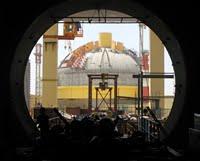If the phenomenon of nuclear renaissance has a true believer, it is India. In the next decade, India envisages monumental growth in its nuclear energy production. Today, nuclear energy contributes only 3 percent of the country’s total energy mix -- a meager 4,200 megawatts. By 2020, India plans to increase nuclear energy production tenfold, to 40,000 MW.
But the question now facing New Delhi is whether hostile public opinion will scuttle India’s nuclear energy expansion. Massive anti-nuclear protests in India have brought progress on the Koodankulam nuclear power plant to a grinding halt. Before that, the Jaitapur nuclear project ran into trouble over safety concerns.
India’s Atomic Energy Commission (AEC) finds itself increasingly challenged by local communities resisting the construction of nuclear power plants in their backyards. In Koodankulam, protests have mainly come in the form of a nonviolent blockade of the plant. But local communities have also organized massive hunger strikes, in which women and children are the most enthusiastic participants. In addition to underscoring the tensions between the AEC and local communities, resistance against the Koodankulam plant also reveals the tension between the national government and the state government of Tamil Nadu. Whereas the national government has unequivocally stood with the AEC on the issue, the state government has sided with the locals, in the hopes of satisfying its political constituencies.

